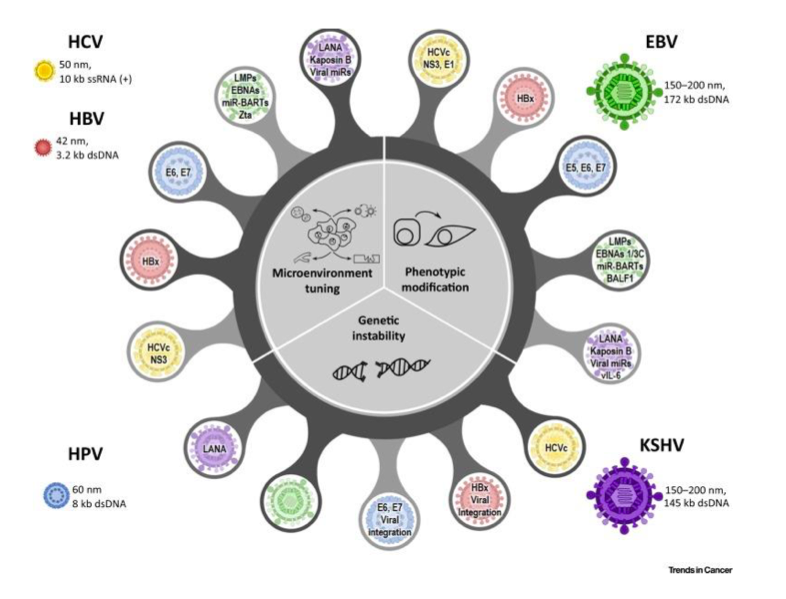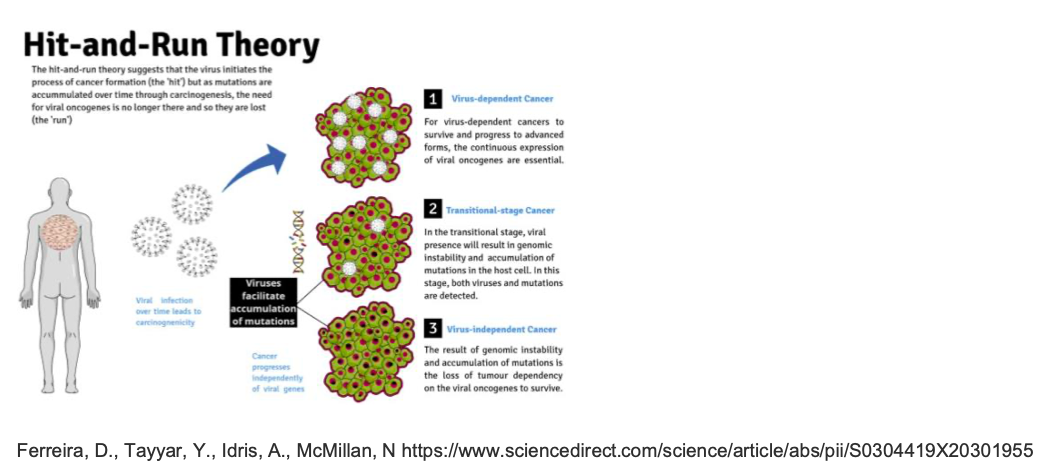Cancer-causing viruses continue to be a significant driver of cancer development. It is estimated that viral infections are the central cause of more than 1,400,000 cancer cases annually, representing approximately 10% of the worldwide cancer burden (Plummer et al. 2016).

Currently there are 7 known viruses that are related to the pathogenesis of cancers (human oncoviruses).
● Human Papillomavirus (HPV) subtypes 16 and 18 - squamous cell skin cancer & cervical cancer (sexual route).
● Hepatitis B (HBV) and Hepatitis C virus (HCV) - hepatocellular carcinoma.
● Epstein-Barr virus (EBV) - herpes family, infectious mononucleosis - genetically
altering B lymphocytes and may cause Burkitt's lymphoma, Hodgkin's and non- Hodgkin's lymphoma, T-cell lymphoma, Nasopharyngeal carcinoma and some forms of stomach cancer.
● Human herpesvirus 8 (HHV-8) - Kaposi's sarcoma (very low infection rate, rare).
● Human T-cell lymphotropic virus type 1 (HTLV-1) related to T-cell leukaemia.
● Merkel cell polyomavirus (MCV) - Merkel cell carcinoma (a type of skin cancer).

HIV is also strongly linked with cancer diagnosis. While it doesn’t directly cause any type of cancer, the immunosuppression that it provokes increases the risk of occurrence of other viruses that are cancer causing.
Having an understanding of the viruses that are strongly linked with cancer is important for professionals working in healthcare. It is crucial in reinforcing knowledge, understanding the driver behind a patient’s cancer and the subsequent decision making around treatment. For example, with EBV driven cancers, the use of monoclonal antibody treatment (Rituximab) to treat and control EBV is often sufficient to control and treat the cancer.

Travel and viral history is an important element of work-up for treatment of cancer, particularly in cancers where the risk of myelosuppression and long-term immunocompromise are high risk. This is mostly pertinent to haematological malignancies, cellular therapies and treatments where long-term B cell aplasia are recognised (Rituximab, Bendamustine). Through these treatments, particularly where transplant is considered or undertaken, virus suppression is required, following the advice and recommendations of infectious diseases specialists.
It is also important for patients to understand the impact of viruses on cancer and cancer treatment. Knowledge and awareness will also contribute to increasing access to vaccination programmes, treatment and viral control, as well as the development of public policy measures in order to institute preventive measures, such as vaccination and screening’s programmes.
A crucial factor in preventing virus-driven cancers is through motivating people to adhere to vaccination and screening programmes. Engaging them is the first step to influencing healthier behaviours. Conducting awareness campaigns for healthy sexual behaviour in schools, for example, can be one of the forms of health education with a significant impact.
Oncology nurses are in a privileged position for having a positive impact in relation to the general population. This is due to the proximity we have with patients and because of the relationship of trust that we develop. We can use this connection to try to instil healthy behaviours to try to prevent infection by viruses which can be a trigger to certain cancers.
You can find more information about viral oncology at these articles:
● Mui UN, Haley CT, Tyring SK. Viral Oncology: Molecular Biology and Pathogenesis. J Clin Med. 2017 Nov 29;6(12):111. doi: 10.3390/jcm6120111. PMID: 29186062; PMCID: PMC5742800.
● Chen Y, Williams V, Filippova M, Filippov V, Duerksen-Hughes P. Viral carcinogenesis: factors inducing DNA damage and virus integration. Cancers (Basel). 2014 Oct 22;6(4):2155-86. doi: 10.3390/cancers6042155. PMID: 25340830; PMCID: PMC4276961.
● P. Lambert, Oncogenic Viruses. Encyclopedia of Microbiology (Third Edition). 2009 Fev 2; 421-429. https://doi.org/10.1016/B978-012373944-5.00308-4. ISBN 9780123739445.